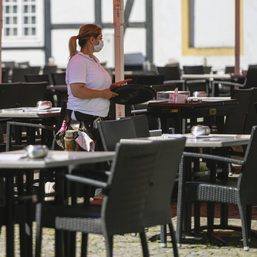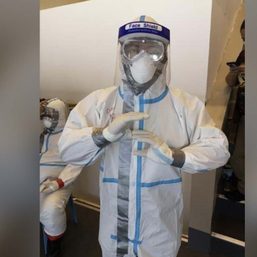SUMMARY
This is AI generated summarization, which may have errors. For context, always refer to the full article.

MANILA, Philippines – As Filipinos, we have always loved raw action. It is innate in us to find adventure in everything we do. It is never hard for us to appreciate a high-adrenaline spectacle whatever gender or age group we belong to.
Every Juan Dela Cruz has their eyes set on each bout to laud the victory of every Filipino boxing greats such as Francisco “Pancho Villa” Guilledo, Gabriel “Flash” Elorde and Manny Pacquiao. There is revelry in every engagement where UFC fighter Mark Muñoz and hometown hero Eduard Folayang take part in. Manila went maniacal when Dave Batista won the world heavyweight title at WrestleMania XXI.
Indeed, we are the combat-adoring capital of Asia. We do not let anything pass; whether it be boxing, mixed martial arts (MMA) or professional wrestling. Yes, you read it right. The fight art called as “Professional Wrestling” is also included.
Pro wrestling had its home in 1989 and was billed as “Pinoy Wrestling”. Unfortunately, it evolved into a local rip-off of the World Wrestling Federation, known today as World Wrestling Entertainment (WWE). Its roster of prized grapplers, dubbed with silly monikers, tickled fantasies but was nothing more than a ridiculous mix-up of irony and sarcasm between people and characters it depicted. Viewers had to bear with the likes of Lawin the Birdman, Turko Turero, Joe Pogi, Macho Franco, The Bakal Boys, Iggy Igorot and many others.
However, the promotion was short-lived. Since then, we have been stuck with an American brand of wrestling. Kids and teens of the 90’s will be able to relate that cable television was necessary in order to follow Raw Is War every Thursday on Star Sports or wait for Cartoon Network to sign off on Fridays to watch World Championship Wrestling’s Nitro.
Despite the occasional visits of foreign wrestling organizations, it was not enough to satiate the hunger and thirst for wrestling. The Filipinos wanted to see a wrestling federation based in the Philippines, similar to Philippine Basketball Association for basketball, Universal Reality Combat Championship (URCC) for MMA, and United Football League for football. The wide extent covered by technology and the accessibility of social media triggered Pinoy hooligans to rally for and begin an uprising, a revolution that would be known as Philippine Wrestling Revolution (PWR).
The formation of the revolution
PWR began in 2012 as a Facebook group for the purpose of establishing a wrestling company. Hardcore wrestling fans from different parts of the Philippines linked and added to the cluster to start fantasy bookings, identity formulation and character conceptualization. Sadly, it held out as a plan or heed only until December 22, 2013.

“It was put together by two fans at first. They tried to get as much people as possible. They also brought in foreign guys on Facebook, who are connected to the wrestling industry. But we really never had serious talks about it until December,” creative and business head Mikers Litton recollected.
The first meeting was called on the said date, and PWR president Yusuf Meer stated that despite being unfamiliar with each other during that time, the founding members already had a shared purpose.
“I came two hours late at that first meeting, and I didn’t have their contact numbers. I found them by chance. It was meant to be. At that moment, we knew it that we’re going to do it,” the head honcho shared.
The decision to push through was further boosted by the partnership offered by Universal Women’s Pro Wrestling REINA. The Japanese-based grappling league held an event, which was headlined by Filipino-Japanese wrestler Syuri Kondo, at the Ynares Sports Arena in Pasig City last January 25, and PWR was tapped to help them in the promotion and organization of the one-night affair.
“One of the agents of REINA approached Nelson ‘Borman’ Aman Jr. (PWR secretary), and then he set a meeting with us. Basically, we helped them to promote the event and contributed backstage manpower for the show. As a matter of a fact, Mikers and I served as commentators. PWR staff served as marshals and assisted to set up the ring,” Meer said.
Litton believes that the joint venture with REINA accorded the proper introduction in the management of a wrestling federation.
“The way everything unfolded for us is like all divine intervention. The REINA event was our introduction to the wrestling business, but it was done in a biggest way possible,” he asserted.
Establishing the PWR trademark
A country that can boast of having a wrestling company gives it an aura of significance because it translates to its overall identity. United States, Mexico and Japan are three of the countries with a huge market and a high popularity of the sport, although their styles are different due to their respective independent development over a period of time.

American wrestling tends to have a heavy focus on story building and the establishment of characters, while Mexico’s Lucha Libre gives emphasis on high flying moves by utilizing the ring ropes to catapult themselves towards their opponents, using intricate combinations in rapid-fire succession and applying complex submission holds.
On the other hand, Japanese wrestling or Puroresu is treated as a full contact combat sport as it mixes hard hitting martial arts strikes with shoot-style submission locks.
Seeing all the vast variety of styles in wrestling, Meer pointed out that PWR will incorporate all essential elements of the fight art and these will be the basis of their trademark.
“The way we are approaching it is not necessarily just sports entertainment. We’re not just going to treat as a hard-hitting style per se. We are trying to incorporate different elements,” he stressed.
PWR wrestlers have undergone training since January 19 and are continuously fine tuning their skills every Sunday at the AFP Gym in Taguig City.
“We’re now building on strength. We’re covering the basics like taking bumps, slams and rolls. As of now, I have five guys who can wrestle. We’re doing practice matches. It’s on-the-spot match. We’re putting it up from five minutes to ten minutes,” PWR head trainer Mark “Bombay” Suarez said.
Even with only a limited time left, Litton is confident that PWR’s inaugural event will tentatively be held in August or September because they were able to open doors of collaborations with other organizations outside the Philippines.
One of the perks that come with their overseas connections is having Joe E. Legend on board to assist them with their preparation.
Legend, whose real name is Joseph Edward Hitchen, is a renowned in-ring tactician who trained the likes of WWE superstars Edge and Christian, plus TNA Wrestling talents Gail Kim, Chris Sabin and Alex Shelley
Litton described the 44-year-old veteran from Toronto, Canada as “wrestling’s best kept secret.”
Battling competition and stereotypes
Of all other combat sports, the Philippines has become a harbor for MMA as it holds three major organizations such as URCC, Pacific Xtreme Combat and King of the Cage.
Besides these, the Singapore-based ONE Fighting Championship has been a frequent guest. Ultimate Fighting Championship is likewise expected to visit the country.
According to Litton, PWR does not consider MMA a rival in the limelight even if companies of the aforementioned sport proliferate the entire archipelago.
“There’s no real competition. There’s only competition when people want competition. But at the end of the day, we’re putting out completely two different products,” he supposed.
Moreover, Litton is convinced that pro-wrestling has an immense leverage over MMA because of its entertainment value.
“Pro-wrestling is entertainment. We can give the fans that you can’t usually get from mixed martial arts,” he added.
Meanwhile, Meer addressed skeptics by disproving numerous impressions of how wrestling matches are carried about.
“A lot of people seem to misunderstand and think that pro wrestling is a phony scripted show with few thrills. Pro wrestling is around to entertain you. You’re supposed to have a good time, like watching a movie or a sport,” he lauded.
This fire burns
It is not easy to keep the fire burning, but Philippine Wrestling Revolution’s surreal dream to bring a fight art back to life is fueled by its passion. Every endeavor must be accompanied by passion for it to succeed. Passion lights the way, ignites desire, and births achievement. It translates dreams into reality.
For PWR’s top brass, it is not only the assurance of being able to revive the professional wrestling scene in the Philippines but the belief that it will be the next prime destination of the sport.
“We wanted to turn the Philippines into a hub of pro wrestling because there are a lot of promotions now hopping into places like Singapore, Taiwan and Hong Kong. However, there is nothing yet in the Philippines. Eight years from now, I would like people to say that the Philippines is a hot bed for professional wrestling,” Litton ended. – Rappler.com
Add a comment
How does this make you feel?


There are no comments yet. Add your comment to start the conversation.